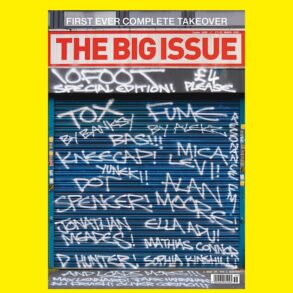The man accused of being behind Melbourne’s most famous bird, which appears on landmarks throughout the city, has found himself caged, at least for now.
Jack Gibson-Burrell from Yarraville, who police say is behind the ubiquitous “Pam the Bird” graffiti tag, was denied bail on Wednesday over allegations he has caused more than $200,000 damage to buildings. The 21-year-old is facing 50 charges including criminal damage, aggravated burglary, shop theft and stealing a motor vehicle.
In court, police said Gibson-Burrell’s offending over two years had broadened “from simple and small acts of graffiti to large-scale criminal damage”.
The historic shot tower in Clifton Hill bearing the Pam the Bird graffiti.Credit: Chris Hopkins
In denying bail, magistrate Johanna Metcalf said there was a risk Gibson-Burrell would continue to vandalise and break into prominent buildings to boost his social media profile.
She also expressed concern about his propensity to commit violence if disturbed while graffitiing. Police earlier told the court of an allegation he had stabbed a man repeatedly and that he entered homes to steal cars while residents slept nearby.
The allegations of violence have, for some, taken the shine off the Pam phenomenon. Spotting the bird has become a collective game of eye-spy for many, although others consider it an eyesore.
In a city that prides and markets itself on its street art – both commissioned and rogue – how will Pam go down in cultural history?
Is it graffiti or art? Who decides? And can we separate the bird from the artist?
We asked four experts for their views:
‘Free the bird’
The simple outline illustration of a bird – often accompanied by a “Srock” tag – found throughout Melbourne is graffiti rather than art, according to Dean Sunshine.
He has documented street art and graffiti across Melbourne for years and self-published two books on the topic.
“Even though Pam is an animal, a bird, it’s still more in the graffiti world than it is in the street art world,” he says.
“The mentality of a graffiti writer is to have his name seen as much as possible and as far and wide as possible. That’s what Pam has done. It’s on freeways all over the place, it’s on signs all over the place, it’s on very visible buildings all over the place.”
Sunshine says Pam cannot be compared to a street artist such as Banksy, even though both tried to be anonymous and appear in unauthorised places.
Dean Sunshine says Pam the Bird is graffiti not street art. Credit: Justin McManus
Banksy’s work references the context of its surroundings and often includes political comment, but with Pam “there’s nothing political about it”.
Sunshine says the “pinnacle” of the graffiti world is painting trains.
The allegations against Gibson-Burrell include multiple counts of breaking into the Newport railway workshops and spraying trains there.
If proven, Sunshine says, that would put him squarely in the graffiti camp.
“[Spraying grafitti] is defacing public property, and in that respect, yes, it is criminal damage – but in saying that, I truly believe that art is not a crime,” Sunshine says.
“Free the bird.”
‘The people involved should be congratulated’
Pam is a unique example of something halfway between a graffiti tag and street art, according to criminologist Professor Alison Young, of the Centre of Cities at the University of Melbourne.
She has studied graffiti for 30 years and interviewed hundreds of street artists.
The bird, in its various forms, merges the repetition of the tag with “street art’s fondness for creating very user-friendly, populist images”, she says.
“It really is a mash-up of old-school graffiti culture with Instagram-friendly street art, and so the people involved should be congratulated, in many ways, for doing that so successfully, because there’s huge public awareness, even before the arrest and all of that publicity.”
Young dismisses Lord Mayor Nick Reece’s description of the tag as idiocy, saying there is obvious thought and skill involved in the works.
“What’s distinctive about the works is they’re all in very different places, [they’re] very different sizes. But they’re all really well thought through,” she says.
“The people have spent time thinking about the shape, and they make it work with the context and with the background, and with the surface that it’s on.
“So it’s not random, it’s not unskilled, it’s not idiocy … it’s someone who understands placement, colour, scale and so on.”
‘Just too far’
Pam the Bird was all fun and games until it started turning up on heritage landmarks such as Flinders Street Station, the Uncle Toby’s silo in Footscray Road, Sunshine, and the Clifton Hill shot tower near Hoddle Street, according to the peak advocacy body for heritage.
“There’s a place for all sorts of heritage in our society, but we need to be respectful of each other and not at the detriment of other cultural heritage,” says Samantha Westbrooke, executive manager of conservation and advocacy at the National Trust.
“A lot of the tagging that was done by Pam the Bird has been really disrespectful, and that just becomes defacing.”
Westbrooke says she and her 11-year-old son were once delighted to spot the wacky bird around the city.
“When it appeared on the shot tower, that was just too far. I just went, ‘Oh yeah. They really are just criminals. They’re doing it for notoriety, not really for any artistic endeavour.’”
Westbrooke says it is necessary and right to pursue the source of the Pam tag – not least to recoup the huge expense in rectifying heritage buildings, which in the case of Flinders Street Station is met by the taxpayer via the Department of Transport.
“It requires detailed work to actually remove it without damaging anything or having to replace significant elements,” she says.
‘A thin line between art and vandalism’
Flavia Marcello, an adjunct professor of design history at Swinburne University of Technology, says whether Pam the Bird is art or not depends on the viewers’ perspective.
“There’s a thin line between art and vandalism these days, and a lot of it has to do with your personal opinion,” she says.
Marcello compares the debate over Pam to that in the early 20th century when abstract art first came on the scene and Russian painter Wassily Kandinsky’s work was criticised as being stupid or naive.
“It’s an evolution of what we think art is. Here we are in a city like Melbourne, where they’re arresting one person but putting perspex over the graffiti of other people,” she says, referring to a Banksy on Flinders Lane that was destroyed in 2008].
Marcello says Pam can be seen as a political act, even though the tags do not contain overt political messages.
In moving from tagging “everyday places or crappy bits of the city that no one cares about” to renowned or major commercial buildings, Pam moved into the realm of being political and could be interpreted as anti-establishment and anti-corporation, she says
Ultimately, Marcello says that whether Pam is regarded as art depends on where it is and what canvas is used.
“Is the canvas a public building? Is the canvas a famous building? Is the canvas a corporate building?” she asks.
“The Novotel is upset because that’s its corporate image, the City of Melbourne is upset because the ‘Cheese Stick’ is a symbol of Melbourne, and God forbid you touch an icon like Flinders Street Station.”
With Erin Pearson
This post was originally published on this site be sure to check out more of their content.








